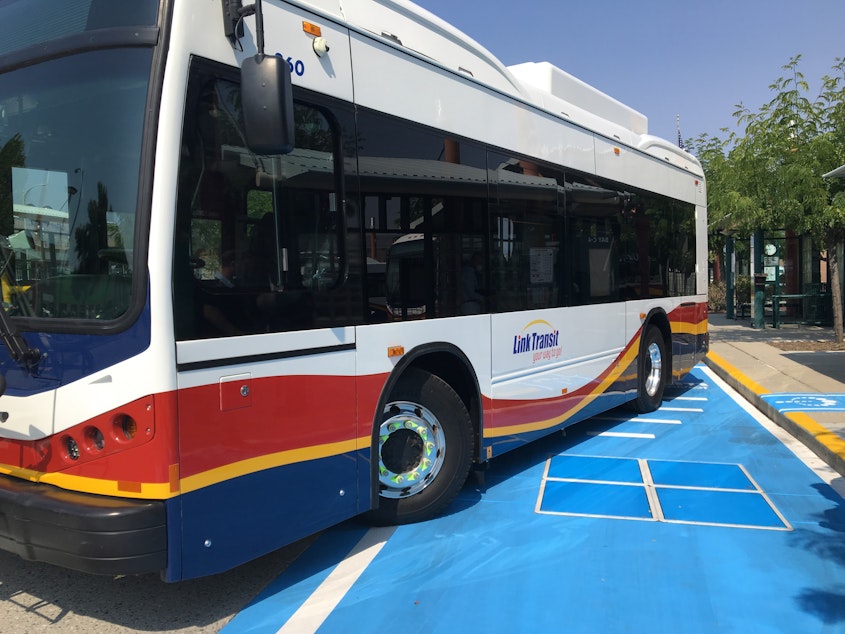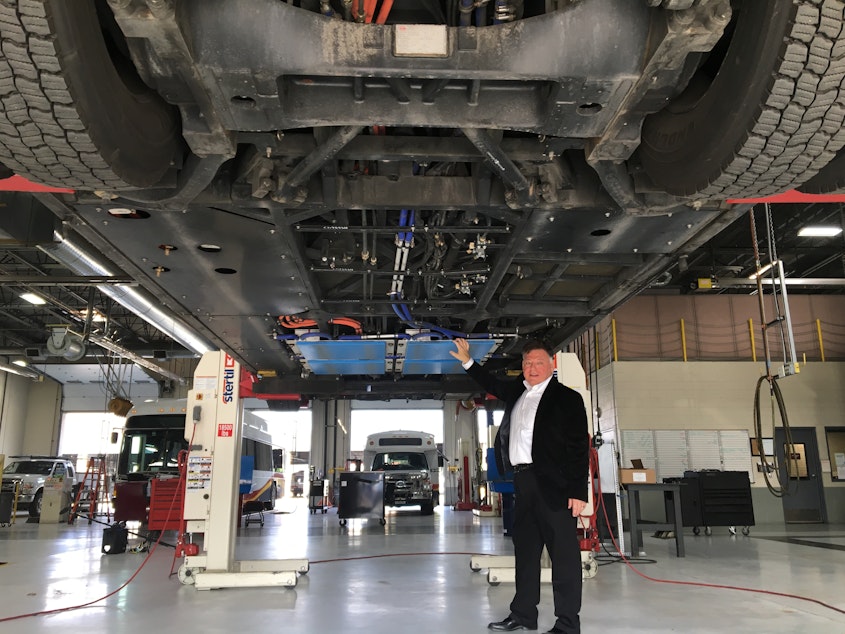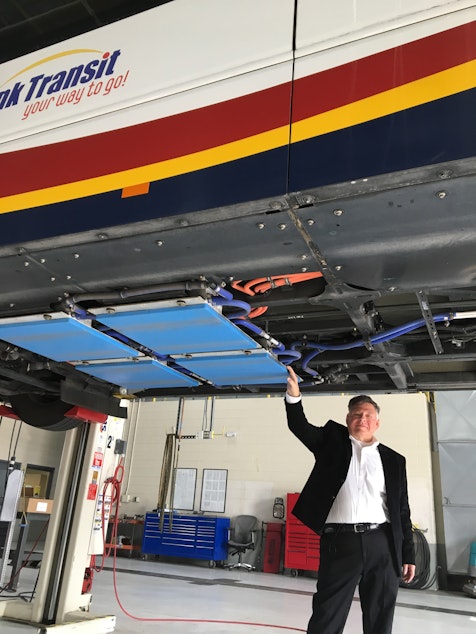Hidden wireless technology keeps buses moving in this rural Washington town

WENATCHEE, Wash. — At a handful of bus stops in the eastern Washington towns of Wenatchee and Leavenworth are secret charging stations.
These charging stations are wireless. They have no power outlets or cables, just some blue paint on the pavement to help bus drivers find them.
Electric buses drive up, release passengers, and charge up while the driver takes a rest break. Electricity transfers, invisibly, between four charging pads embedded in the concrete and four more attached to the bus's underbelly.
Diane Barajas waits for a bus to take her to her work at a warehouse packing apples and cherries. About a quarter of Wenatchee’s bus fleet is electric, and Barajas said she prefers them. In Spanish, she said that electric buses take better care of the planet by stopping a lot of pollution while still providing transportation for those who need it.
Even this fan of electric buses said she hadn't noticed the easy-to-miss transportation innovation in the ground at her bus stop.
By recharging batteries throughout the day from wireless chargers installed in the pavement, electric buses in the Wenatchee area can cover 350 miles a day – an exceptional range for an electric vehicle – according to Link Transit, the public transit agency for Chelan and Douglas counties.
Sponsored
Electric buses are nothing new, and rural Link Transit has few of them compared to King County Metro in the Seattle area.
Thanks to King County’s nearly 200 electric buses, mostly trolley buses tethered to overhead power lines, Washington state has more electric buses than any other state except California.
Still, this town surrounded by fruit orchards and sagebrush, a mountain range away from the high-tech hubs of the Seattle area, has become an unlikely hotbed of a wireless technology that could help the world fight climate change.
“It was something we did by ourselves first,” said Richard DeRock, general manager of Link Transit. “People were willing to take the risk to go forward.”
Getting all kinds of motor vehicles to run on electricity instead of petroleum is a top priority for President Joe Biden and Washington Governor Jay Inslee as they try to curb greenhouse gas emissions.
Sponsored
“It's taken 12 years to get there. But we've gotten there.”
Andy Daga is founder of Momentum Dynamics, the charging system’s Pennsylvania-based inventor. Standing in a Link Transit garage beneath one of the world's first wirelessly charged electric buses, he noted four checkerboard-sized blue squares under the bus.

“These four blue squares are the receivers that take energy provided from four other blue squares that are in the pavement,” Daga said. “Those four pads in the pavement create a magnetic field. The magnetic field is received by these four pads that you see on the underside of the bus, and they take the magnetic energy and convert it back into electricity.”
It’s called magnetic induction, the same process used on a larger scale in power plants and on a smaller scale in wireless chargers for phones and electric toothbrushes.
Sponsored
“You never need to use a cable,” Daga said. “A person never needs to plug it in.”
Wenatchee bus driver Lori Barnes said she loves driving the electric buses and that charging them is easy: Park the bus on the right spot and it charges automatically.
“They're very quiet, good for the environment, do not smell like diesel, and I just enjoy them,” Barnes said. “You can actually drive up to a guest at a bus stop, and they sometimes don't even know you're there.”

Sponsored
The big, quiet buses haven’t always worked so well. As an early adopter, Link Transit has suffered many glitches.
“The fatal flaw in electric vehicles is how far can you go on a charge,” DeRock said.
The agency’s first-generation buses a decade ago could only drive 18 miles and had to be recharged every half hour.
DeRock said more recent buses have had problems too.
“We had problems when it got cold, and we had problems when it was hot," DeRock said. “They just did not work for our environment.”
Sponsored
When it got below freezing, buses could go just half their normal range before running out of juice. On hot summer days, the lithium batteries wouldn’t charge at all. So Link Transit added a battery heater and a cooling system to let the batteries work year-round.
DeRock says the newest buses, put in service in 2019, are the most reliable in the fleet. Wireless charging has boosted their daily range by more than half.
“It's taken 12 years to get there,” he said. “But we've gotten there.”

With the buses working well and climate scientists urging a rapid overhaul of energy use worldwide to fend off climate catastrophe, why not make all the buses electric?
DeRock said that some of the diesel buses in the fleet have six to seven years left on them, and it takes time for electric buses to be ordered and built.
Wenatchee has a major advantage over other cities as it turns to electricity for transportation: Electric power is cheap and climate friendly here.
The mighty Columbia River, stapled with big dams that generate hydropower, runs past the town.
“Wenatchee is unusual because it gets 100% of its power from hydroelectric,” Daga said. “These vehicles truly are zero emission all the way around.”
Electric buses and their chargers generally cost more upfront, but less to operate, than diesel buses. Wenatchee has relied on state and federal grants to make its jump into electric transit.
DeRock said switching to electric buses costs less over the life of a bus than continuing to use diesel.
Daga said that even in regions with more expensive power, electric transportation would still be cheaper, given the prices of gas and diesel.
"They're making a lot more diesel buses than electric buses," said Washington Secretary of Transportation Roger Millar. "Diesel buses are a cheaper upfront cost. We need to address that inequity to get the electric buses into the fleet. Once they're at scale, they're going to be the way to go."
Link Transit officials say they’re happy with their current buses and chargers, though three of their four new chargers had manufacturing defects. Momentum Dynamics says the defects arose from pandemic-related disruptions and that it is replacing the faulty chargers at no cost.
Nationwide, 98% of buses still burn fossil fuels in internal combustion engines, according to the American Public Transit Association.
Whatever energy source propels them, buses generally use much less energy per passenger than cars or trucks do. Getting more people to switch to transit may be the bigger climate challenge for transportation agencies large and small.
In the Wenatchee area, where traffic is dominated by gas-guzzling SUVs and pickup trucks, Link Transit carries just 1.5% of total trips, according to DeRock.
Transit officials in Wenatchee plan to order eight more electric buses next year. They aim to have half their fleet running on climate-friendly electricity in two years and to be fully electric in six.




